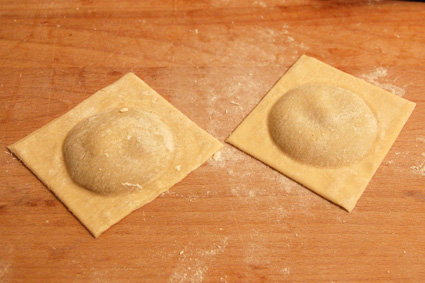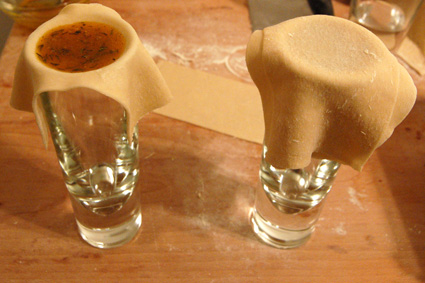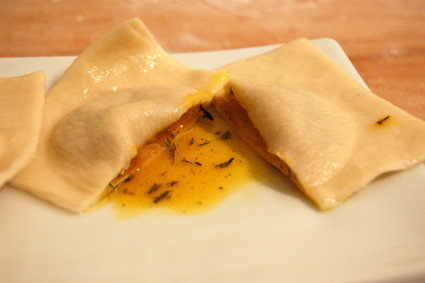How, you ask,1 can one make the poached egg unnecessarily complicated? One way - as I'm sure your choices are manifold - is to make ravioli.

It's really more of a novelty than the sort of dish you might make on a regular basis, but it definitely opens up the door for some unusual sorts of filled pastas in the future. Maybe.
The impetus for the poached egg ravioli - for lack of a better term - came because I've been putting together a special menu for my friend Melissa's upcoming birthday. We'll be in London to visit her then, and I'm planning a multi-course meal2 to celebrate. Keeping in mind that I'll be working in a foreign3 kitchen, scrambling for time and battling jet lag, it's a fine balancing act between food that tries to be elegant and a little innovative - or at least less than ordinary - and stuff that I can prepare and serve before the night disappears. I start with ideas that may be over the top, then scale them back.
Ravioli with a liquid center were definitely over the top. Pasta encasing its own sauce, if you will.4
I'd tossed about a few variations, considering how they might work. It could be as simple as tomato (or other) sauce, held inside and warmed through as the pasta cooked. Or, stepping up the complexity, a sauce bound with gelatin that could hold its shape while cold, then melting as it cooked. The problem, though, is that there didn't seem to be any benefit to doing things that way, except for the fun of cooking it. I don't suppose that egg yolk's significantly different, though making a poached egg in this way does offer an advantage or two.
The primary benefit, as I see it, is that this is a way to introduce additional flavors into the egg, while still maintaining that magical, breakable pouch of yolk. For this first attempt, I added some salt, black pepper and thyme, just to see how it would turn out, but the potential's pretty limitless. I'd really like to try it with a squid ink pasta sometime, assuming I can find some.

The process was fairly straightforward, though I made every effort to move quickly to keep the pasta supple and to avoid having the yolk filling's moisture oversaturate and weaken the ravioli. It went more or less like so:
- Separate the eggs. I used the yolks for the filling, and the whites to make the pasta dough.5 One could go the other direction, allowing the whites to set in the filling, for an interesting variation.
- Beat and flavor the yolks. With care, you could keep the yolks intact, using one per raviolo, but I don't trust myself with something that delicate. This way, I could mix in the flavorings as thoroughly as I liked, and could fill ravioli of any size.
- Knead and roll out the pasta. A pasta machine isn't necessary, assuming you've got fantastic rolling skills. I don't. So I ran the dough through the Atlas to number six, because I was hurrying and hadn't sufficiently developed the gluten network to go thinner. I'd recommend rolling it out as thinly as possible - eight, if you can - for the best texture. At that thickness, you might even be able to see a hint of the golden filling through the dough.
- Fill the ravioli. I used some tall, skinny glasses as forms, allowing a layer of pasta to droop down to form a small bowl. Then, with a pastry brush, I daubed on a little water, pressed on another layer of pasta to seal, and trimmed the edges on the cutting board. You'll have a lot more pasta than filling, so be generous with the pieces used to create the ravioli and eat the scraps later.
- Poach very gently. Sliding them carefully into a barely simmering6 pot of water, I waited three minutes, and plucked them out with a slotted spoon.

Al dente pasta filled with an herbed, runny yolk. If you look closely, you can see how the outer layers of yolk, against the pasta shell, have solidified, leaving just the core to run out onto the plate. Instant, rich, eggy sauce. Gimmicky? Yes. But they tasted great, and I'm thrilled that it worked out on the first try.
Enough to try it again, for sure.
* * * * *
1You did ask, right?
2I know the menu, and Sharon has a pretty good idea, but otherwise it's a secret. Besides, it's all dependent on what's available at the Borough Market, so any plans are tentative, at best.
3Quite literally.
4Like the dog food that makes its own gravy. Only... never mind.
5Flour plus liquid, kneaded to develop the gluten, is the basic recipe for fresh pasta. Egg, especially the yolk, gives it a golden hue and a distinct richness, but I suspect that just about anything would work. For flavored pastas, I still use an egg-based dough, adding enough pureed spinach or tomato paste or whatever for flavor and color.
6Simmering, not boiling. There should be just the barest hint of bubbles breaking the water's (or stock's) surface.

1 comment:
Well! Somebody deserves a pat on the back. A for effort. And I am assuming A for taste as well.
Post a Comment